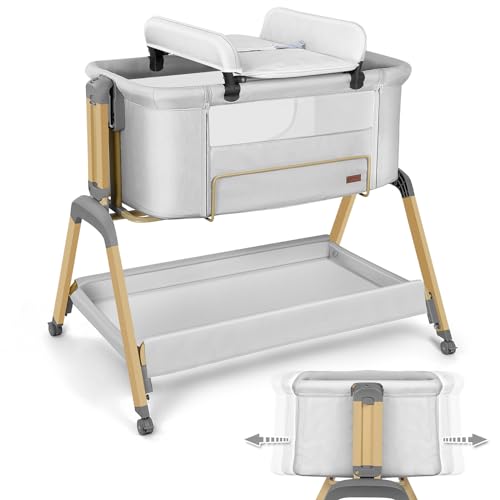Why You Should Be Working With This Bedside Cot For Baby's Room
The Ultimate Guide to Choosing a Bedside Cot for Your Baby's Room
As new parents prepare to invite their little ones, among the most important issues is developing a safe and comfortable sleeping environment. A bedside cot is a significantly popular choice, providing benefit and comfort. This article explores the advantages of bedside cots, key features to consider, their benefits over traditional cots, and responses to frequently asked questions.
What is a Bedside Cot?
A bedside cot, likewise called a co-sleeper or side-sleeper cot, is created to connect safely to the side of the parent's bed. This innovative sleeping service enables easy ease of access, making it possible for parents to tend to their baby's needs without the need to leave their own sleeping space. Bedside Crib For Attachment Parenting fosters a bonding experience, as parents can quickly reach their baby for feedings and comfort throughout the night.
Benefits of Using a Bedside Cot
Bedside cots provide numerous advantages that standard cribs may not offer. Here are some key advantages:
- Convenience: Bedside cots allow parents to be close to their baby without jeopardizing space or security.
- Safety: Many bedside cots fulfill security requirements and design functions to ensure the baby can not roll out onto the floor.
- Breastfeeding Friendly: Mothers can quickly breastfeed throughout the night without needing to rise.
- Easier Sleep Training: Bedside cots can make sleep training much easier as babies feel safe being close to their parents.
Secret Features to Consider When Choosing a Bedside Cot
When selecting the right bedside cot for your baby's room, remember the following necessary functions:
1. Security Standards
- Ensure the cot satisfies local safety regulations and requirements. Try to find a cot that has breathable mesh sides for better ventilation.
2. Height Adjustment
- Search for a cot with adjustable heights to suit your bed's level, permitting a safe fit and decreasing the danger of gaps.
3. Stability
- Guarantee the cot has a durable frame to prevent tipping. Stability is crucial for safety.
4. Portability
- If travel is expected, think about a light-weight design that can easily fold or disassemble.
5. Convertible Features
- Some cots can transform to a bassinet or playpen, permitting extended use beyond infancy.
6. Mattress Quality
- Look for a firm, appropriately fitted mattress that fulfills safety requirements to support the infant's fragile body.
7. Ease of Assembly
- A cot that is easy to put together and dismantle can save time and disappointment, especially for new parents.
8. Price Range
- Budget plans can vary; identify in advance how much you want to invest in a bedside cot.
Comparisons: Bedside Cot vs. Traditional Cot
Function
Bedside Cot
Traditional Cot
Availability
Easy access from bed
Needs full motion to reach baby
Co-sleeping Functionality
Developed for co-sleeping
Not suitable for co-sleeping
Size
Usually smaller sized for space performance
Standard crib size
Portability
Typically more portable
Much heavier and less portable
Connection with Parent
Straight attached to the moms and dad's bed
Freestanding, requiring range
Adaptability
Can transform and adapt to numerous phases
Mainly for setting infant down
Often Asked Questions (FAQs)
1. Are bedside cots safe for newborns?
Yes, if effectively established according to security standards and connected safely to the parent's bed, bedside cots are safe for newborns.
2. Can a bedside cot prevent SIDS (Sudden Infant Death Syndrome)?
While no cot can guarantee avoidance of SIDS, using a bedside cot motivates safe sleep practices, permitting parents to monitor their baby carefully.
3. How long can a baby use a bedside cot?
Generally, babies can use a bedside cot from birth up to around 6 months old, depending on the specific weight and height limits set by the maker.
4. Do bedside cots include a mattress?
Many bedside cots include a mattress; nevertheless, it's important to examine that it adheres to safety standards and fits well within the cot to avoid spaces.
5. Can you use a bedside cot with a bed that has a high frame?
Yes, numerous bedside cots include adjustable heights to accommodate various bed heights. Always measure the bed height to make sure a proper fit.
6. What is the finest material for a bedside cot?
Search for natural materials such as solid wood or organic products that are totally free from harmful chemicals, guaranteeing a safe environment for your baby.
A bedside cot can significantly boost the experience of new parents, offering the availability and security needed during the newborn stage. With careful consideration of the functions laid out above, parents can pick a bedside cot that best fits their family's requirements. By purchasing a quality bedside cot, parents can delight in more peaceful nights, understanding their baby is nearby, secure, and comfortable.
Secret Takeaways
- Bedside cots provide convenience, security, and convenience for both parent and baby.
- Crucial functions to consider include security standards, stability, and size.
- Always guarantee you select a cot that meets safety regulations and matches your lifestyle.
Creating a nurturing environment for a baby doesn't end with the cot choice but begins there, supplying convenience and security for a relaxing night's sleep.
